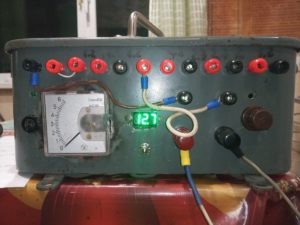
I want to add a few words to the title right away: a reliable, trouble-free and cheap car charger with a wide range of operating voltages.
Before creating this charger, I myself set the following criteria for a future device:
- A minimum of elements to maximize reliability.
- The ability to have an output voltage from 1 to 20 volts.
- Rated charging current up to 6 A.
- Indication of voltage and current on the front panel.
Of course, all this was implemented. And at the end of the article - a link to my video on YouTube, about this charger .
Here is my monster! The weight of the body alone (bought for a penny at the metal site), according to the plate -5 kg. However, this is not critical for me, because. the charger will be stationary. But how I made a portable charger ... I will show in the next article.
The circuit is of course the simplest, but ... as you can see in the photo above and in the diagram below, the secondary winding has many taps.
It is with a bunch of taps from the secondary that I have the ability to adjust the output voltage. Of course, there is no smoothness ... oh well. We regulate discretely.
My transformer has two coils. Accordingly, 2 secondary windings. I used one of the windings without taps (Just in case, I made 5 taps, but they are not used. This is for the future. There is an idea for further refinement). Brought the beginning and end of the winding. U=10V.
At the other winding, I made taps in 1 Volt increments. And a total of 10 V.
All ends and taps of the windings, brought through the feed-through connectors to the front panel. By connecting at different points, I eventually have the opportunity to receive voltage from 1 to 20 volts in 1-volt increments.
The ends of the diode bridge are also on the front panel. Let me explain why...
Switching occurs with the help of two jumpers: from the “change” input of the diode bridge to the row of winding terminals located on top.
Yes, it's a bit inconvenient. But it's reliable. This is more important for me.
Parallel to the fuses (on the primary and secondary), LEDs with additional resistance are installed. In normal operation, they will not glow. But as soon as the fuse blows, current will flow through the LED and it will start to glow. So we will understand that he is out of order.
As you can see in the photo, I have a digital voltmeter. Very bright. I don't always need it. Therefore, in series with him, I put the toggle switch.
The current is ... always controlled.
The main purpose of the device is to charge 12-volt car batteries. But! By switching the jumpers to the desired position, you can charge both 6 volt and 4 volt.
And it's easy ... to feed some kind of low-voltage consumer that is not picky about ripple and voltage stability.
Well, now the promised video on YouTube: